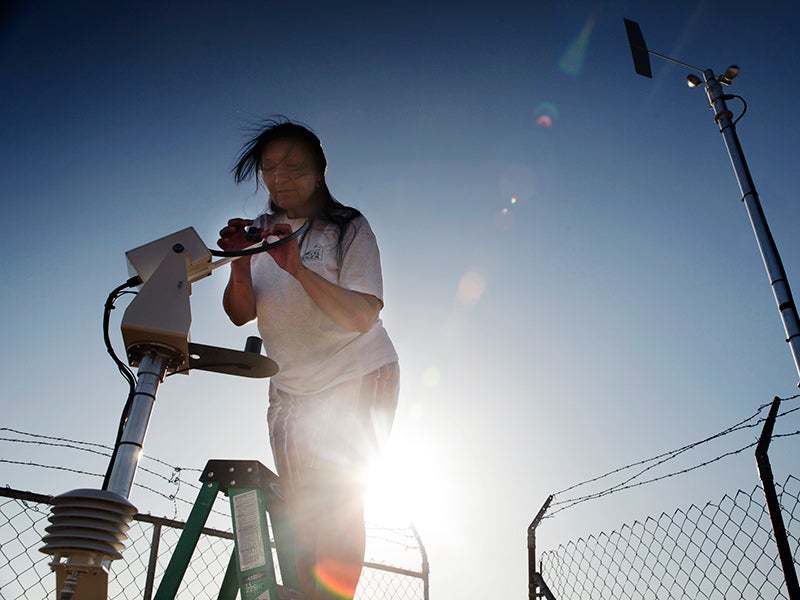Wake and Smile, the Nightmare is Over
In a vote last night, the Nevada Assembly approved SB123, a landmark bill that shifts the state away from coal-fired power. The bill closes Reid Gardner, directs NV Energy to eliminate 800 megawatts of coal-fired power generation from its portfolio, and mandates 350 megawatts of renewable energy development.

This page was published 12 years ago. Find the latest on Earthjustice’s work.
“It felt like I was waking up from a nightmare. I wasn’t really sure what was true or false. I was confused. My heart was racing. I was excited. Maybe, I thought, this nightmare is over.”
This is what Vickie Simmons remembers feeling when she first heard that the Reid Gardner coal-fired power plant might be closing. Simmons is a leading member of the Moapa Band of Paiutes Health and Environmental Committee, and for years she and the rest of the Paiute tribe have lived in the shadow of Reid Gardner’s smokestacks and waste pits. They have paid incredible health costs and reaped little economic benefits.
But Simmons is right – the nightmare is ending.
(Photo of Vickie Simmons by Chris Jordan-Bloch)
In a vote last night, the Nevada Assembly approved SB123, a landmark bill that shifts the state away from coal-fired power. The bill closes Reid Gardner, directs NV Energy to eliminate 800 megawatts of coal-fired power generation from its portfolio, and mandates 350 megawatts of renewable energy development.
“When we first started to call for the closure of Reid Gardner, we were told it couldn’t be done,” said Simmons. “Now, with this legislation, we are close to our goal. The coal plant that has for years poisoned our reservation will finally close and be cleaned up.”
Reid Gardner sits 50 miles north of Las Vegas and less than one mile from the homes of Simmons and the other tribal members. For years the plant has rained pollution on the community. High asthma, cancer, heart and thyroid disease rates plague the reservation.
Years ago, Simmons lost her brother due to pollution she blames on the plant. Last week, she lost a friend. Former tribal chairman Calvin Meyers died at age 57.
“Sometimes when the wind blows wrong, I can taste it,” Meyers, who lived closest to the plant, said. “So you can’t get out. You’re essentially imprisoned in your own home.”
(Photo of former Tribal Chairman Calvin Meyers by Chris Jordan-Bloch)
Meyers was an environmental champion who died much too young. If he were alive today though, he would be smiling as comments that echoed his own made it from Moapa to the floor of the capitol.
“Coal-fired power plants have long polluted our state, threatening the health of thousands of Nevadans,” said Assemblyman David Bobzien, D-Reno, said on the Assembly floor. “Nevada has a bright future with clean energy.”
The Moapa Band of Paiutes agree with Bobzien. For the past several years they have been creating the largest solar plant on a native reservation in America. The plant will provide jobs and more than 250 megawatts of power.
“Our goal is not to be part of the problem, but to be part of the solution,” Tribal Chairman William Anderson said.
(Photo of Tribal Chairmain Willian Anderson by Chris Jordan-Bloch)
Earthjustice has been honored to fight alongside the Moapa Band of Paiutes in their search for the solution as they move from coal to renewables.
We have represented them in court cases about coal ash and air pollution. We have brought their members and their message to Washington, D.C. I even had the pleasure of creating a film and traveling to film festivals with members of the tribe to spread the word about their fight for health and clean energy.
We still have a long way to go to make sure that the law is implemented and that Reid Gardner is properly cleaned up and put away.
But let’s worry about that tomorrow. Today is a day to celebrate. The nightmare is ending. So open your eyes and smile, clean energy is not the future. It is now.
(Photo of Vickie Simmons at Solar Station by Chris Jordan-Bloch)
Watch An Ill Wind, a short film about the situation in Moapa:
The California Regional Office fights for the rights of all to a healthy environment regardless of where in the state they live; we fight to protect the magnificent natural spaces and wildlife found in California; and we fight to transition California to a zero-emissions future where cars, trucks, buildings, and power plants run on clean energy, not fossil fuels.
Earthjustice’s Washington, D.C., office works at the federal level to prevent air and water pollution, combat climate change, and protect natural areas. We also work with communities in the Mid-Atlantic region and elsewhere to address severe local environmental health problems, including exposures to dangerous air contaminants in toxic hot spots, sewage backups and overflows, chemical disasters, and contamination of drinking water. The D.C. office has been in operation since 1978.